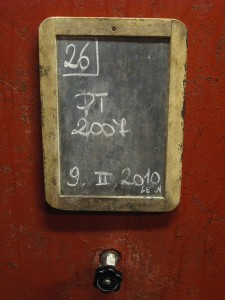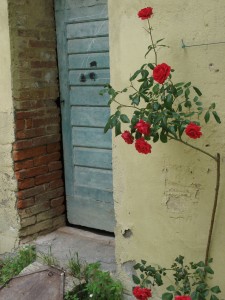Chianti Classico, May 2010 – a point of view
Author: David Berry Green
After visiting 41 Chianti Classico cantina over 11 days I now feel a certain grasp on what’s going on among the Tuscan hills. I also got a grip on the twists and turns in the road, aided and abetted by my mate Tom (Tom). True ‘he’ occasionally threatened to lead me up the garden path, requiring a gentle tap on the ‘shoulder’ bringing ‘him’ back in line. It’s a nice metaphor, in my view, for what’s going on ‘down under’ in ‘Chiantishire’ that is…
That view’s very different to the one I’m used to here in the Langhe, Piemonte. It’s not simply because of the predominance of (Tuscan) woodland over vine – leading to a certain isolation, non? – but also there appears to be a cultural aspect too. Despite an ancient Etruscan history, I found that in too many cases the ‘cultural’ bit seems to have been lopped off the prefixes ‘viti’ and ‘vini’. Surely ‘viticulture’ and ‘viniculture’ are more than just the cultivation of grapes and production of wine thereof? What of that interaction between the land and its people, preserving heritage and communities; enriching lives at all levels through cultural and product integrity? It’s what makes wine more than just an alcoholic drink, does it not?
I arrived in the expectation that Sangiovese – a cultured rosy (not black) pearl if ever there was one – had never tasted so good. Since the DOCG was awarded in 1984, the Chianti Classico Consorzio (representing the growers) has reduced the defective wines of the immediate post war period. Via the ‘Chianti Classico 2000’ project they’ve helped producers improve their viticulture through better clones, advice on training methods, planting densities etc.. The upshot being vineyards designed for quality wine production and not ones that characterised the polycultural existence of yesteryear. Significantly it’s also reduced disease pressure and so in theory the use of chemical sprays. In short the potential for Chianti Classico producers to make delicious, elegant Sangiovese, in pale purezza ideally, that sings, as only it can, of the prized alberese (calcareous) and galestro (schistous) soils of Gaiole, Radda, Panzano, Castellina, Greve and Castelnuovo Berardenga is well within their reach, and yet, and yet…
…the market has changed. Recent enlargements of the (7,500 hectare Classico) zone, particularly an additional 1,200 hectare of (unpoliced) IGT Toscana, along with eyebrow-raising investments in nearby Montalcino (again in less than prime soil) and further south ‘on the beach’ – sorry – in the Maremma, has only added to the woes. The marketplace is crammed, especially in the USA but also at home, with producers of every size forced to go that extra mile to catch the eye.
 This has led to too many producers seeking an exaggeration of colour, fruit and concentration in their once elegant wines. High planting densities might work for Merlot or Cabernet but don’t suit Sangiovese, leading to high alcohol fruit bombs that could have been made anywhere in the world. Then there’s the noble adoption by artisan producers of organic and biodynamic techniques in the search of terroir expression and differentiation…aped by larger entities chasing the same labels for other less honourable reasons.
This has led to too many producers seeking an exaggeration of colour, fruit and concentration in their once elegant wines. High planting densities might work for Merlot or Cabernet but don’t suit Sangiovese, leading to high alcohol fruit bombs that could have been made anywhere in the world. Then there’s the noble adoption by artisan producers of organic and biodynamic techniques in the search of terroir expression and differentiation…aped by larger entities chasing the same labels for other less honourable reasons.
Crucially I sensed that there are too many absentee landlords, whether displaced internationals or historic families who should know better, now relinquishing control to ‘(in)famous’ consultents in return for wine journal points, access to ‘key’ journalists and to favourable sales channels….just as they once handed the keys to the contadini tending their land according to the Medieval ‘mezzadria’ system. This has in turn led to a compromise of the unique Chianti Classico brand; something in my view that needs to be articulated and protected, both in content and style. Among those on the right track, despite (they admit) sacrificing ‘Points’, are Badia e Coltibuono, Isole e Olena, Il Borghetto, Felsina, Bibbiano, Montevertine, Poggerino, Villa di Geggiano, Castello di Ama, Riecine, Monte Bernardi and San Giusto a Rentennano…
As Marco Pallanti, mercurial winemaker at Castello di Ama, and also President of the Consorzio, points out: ‘There’s a risk that the consultant becomes too important, for it’s the land that should lead the winemaker, not the other way round. He quotes Henri Jayer in saying that we need to understand the technology more so as to be able to do less.





A very interesting point of view. Most of Tuscany is well described by you words but there’s also a let’s say not reveled Tuscany that is surprisingly rich in finesse and elegance rather then powerfulness and structure.
Some sugestions:
Monteraponi riserva il Campietello 2006
Castell’In Villa riserva 1995 or 2001 or 2004 or 2006
Castello di Monsanto riserva il Poggio 1999 or 2001 or 2004 or 2006
Le Porte di Vertine riserva 2006
Le Cinciole both chianti classico and Riserva.
Montegrossi
Pacina
as well as the best known Montevertine, Fontodi, Felsina
and talking about Montalcino
Le Ragnaie
Poggio di Sotto
Le chiuse
Stella di Campalto
Case Basse by Gianfranco Soldera
Salvioni
Piancornello
Most of them are not simple farmers but the wines are amazing.
…..well talking from the Italian point of view.
Thanks Teo for your compliments. Pls bear in mind that my piece concerns only Chianti Classico & does not cover the rest of Tuscany (later!) I think we’re on the same side, although I do take issue with a couple of the estates you list as being too extracted/forced/scuro! I work with Stella di Campalto, introducing the wines to the UK & admire the wines of Soldera so we’re close enough. The great challenge, secondo me, going forward is to re-educate a generation of (International) palates used to dark, heavy Brunello, Nobile, & Chianti Classico that Sangiovese actually produces light, fine, elegant DRINKABLE wine in the mould of Nebbiolo; but then the consumer’s been hoodwinked (by journalists/consultants, tasting not drinking) into thinking that dark = real, light = dilute! Are you with me?!
DBG
We are definitely on the same side. I do understand your point of view and also your doubts about Tuscan style if compared with Piedemont. I think that there are many historical and cultural differences that devide the to approaches to wine growing and producing.
I absolutely agree with you concerning the over exctract and muscolar wines that were very interesting to critics and wine journalist for many years. Many things have been change in tha last couple of years. I’m not that confident with the UK market but in Italy as you pointed out as well the interest for fine and elegant wines is growing constantly. Most people are after drinkable wines rather then powerfull and rich.
Tuscany and Chianti Classico didn’t care about that for several years. The best known estates had lost most of their quality and personality and position on the market. There some small producers that are doing very well but there are enormous problems for those new producers to pop out and to be discovered.
I looking forward for your notes of the other areas of Tuscany.
Cheers.
Teo
David,
I had a long conversation with Sean O’Callaghan at Riecine last month on this same topic, touching on the Mezzadaria system and how things used to be. Sean outlined much of what you write about here in a short video we shot. I work with Sean in Chicago, IL, but I think the educational value of the story makes it worth sharing here.
http://www.youtube.com/watch?v=EI2bYWE_QJE
Cheers,
Damien